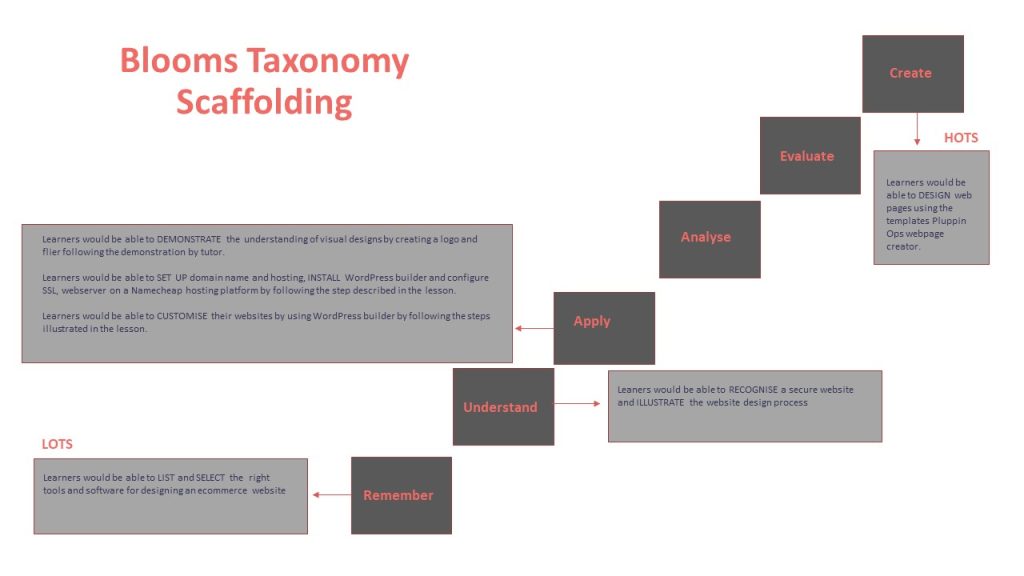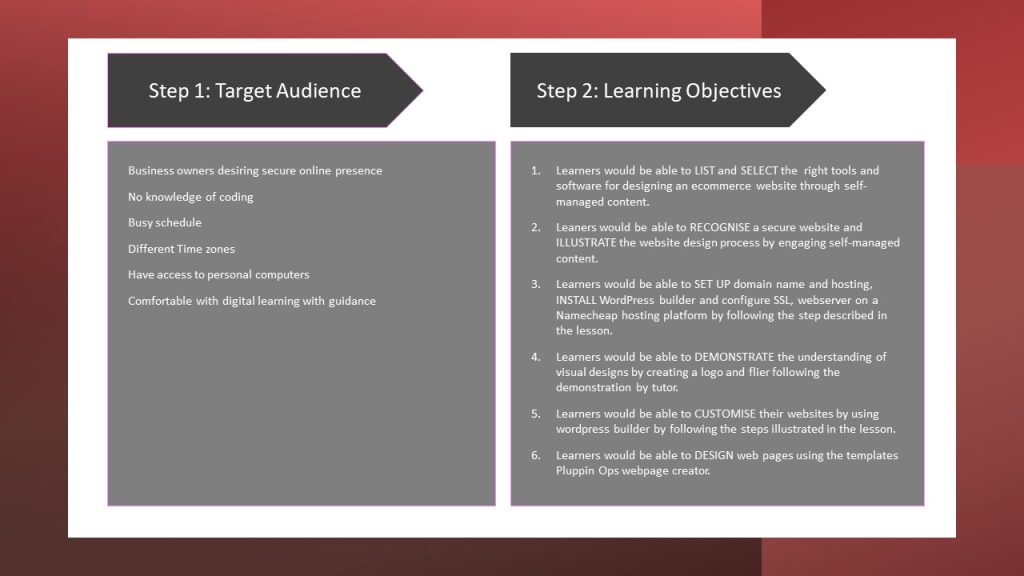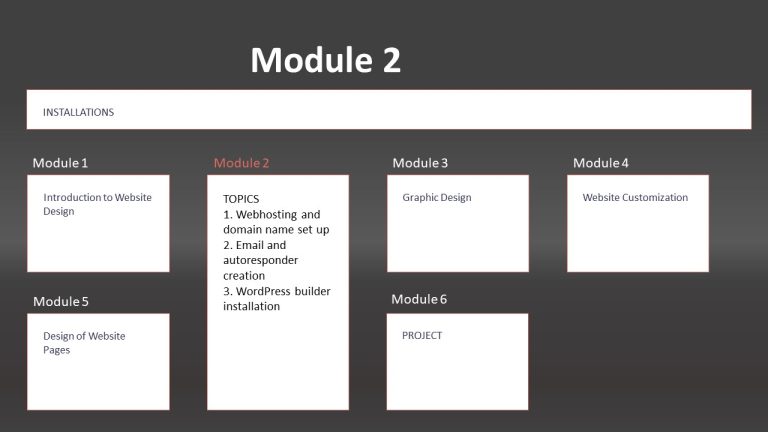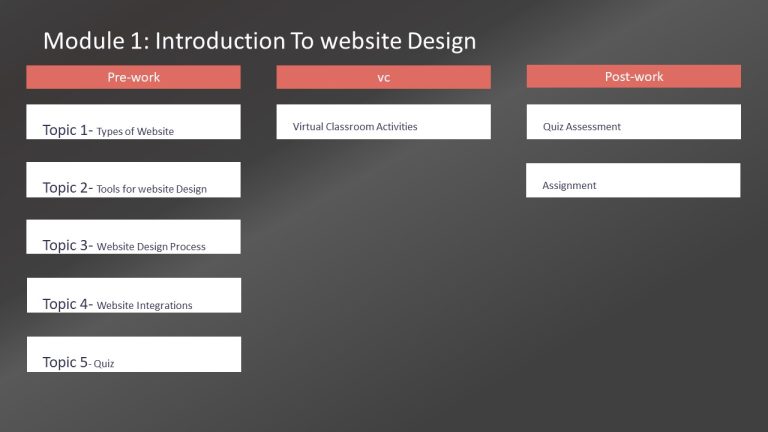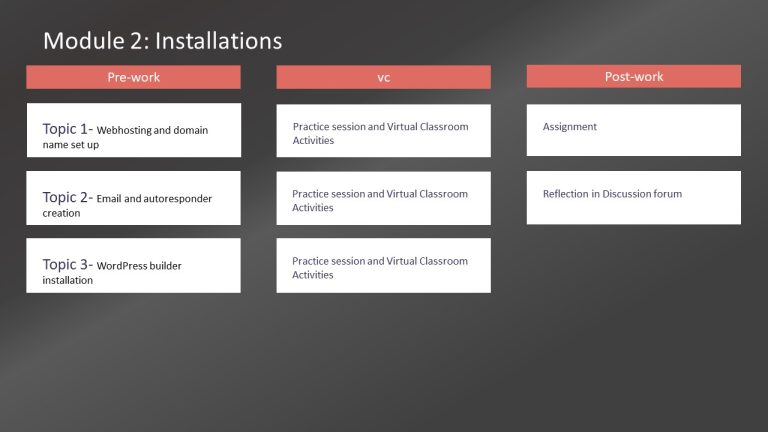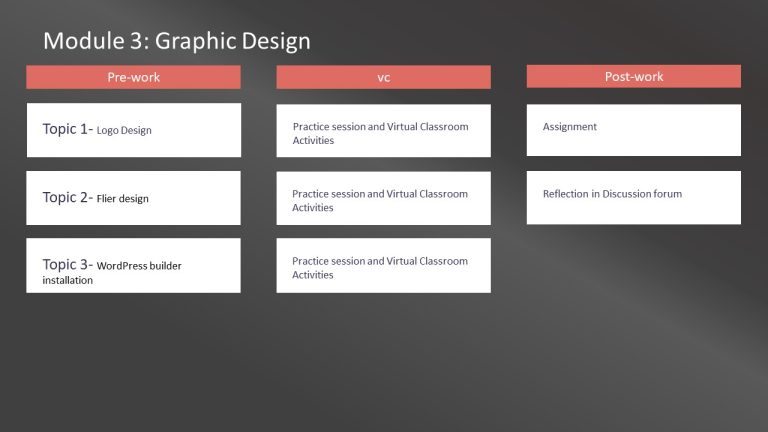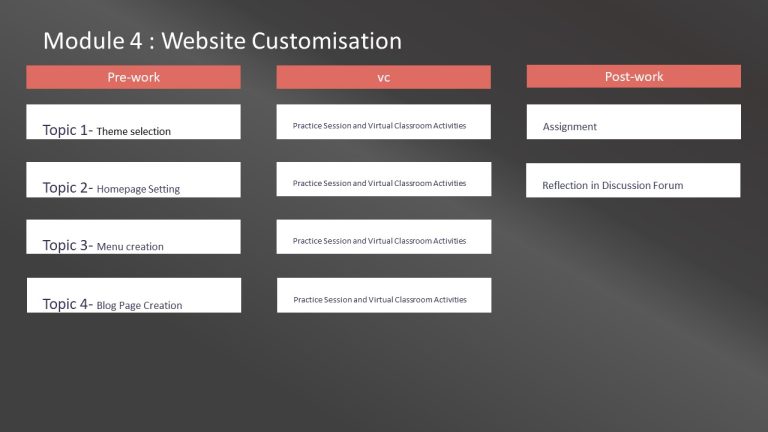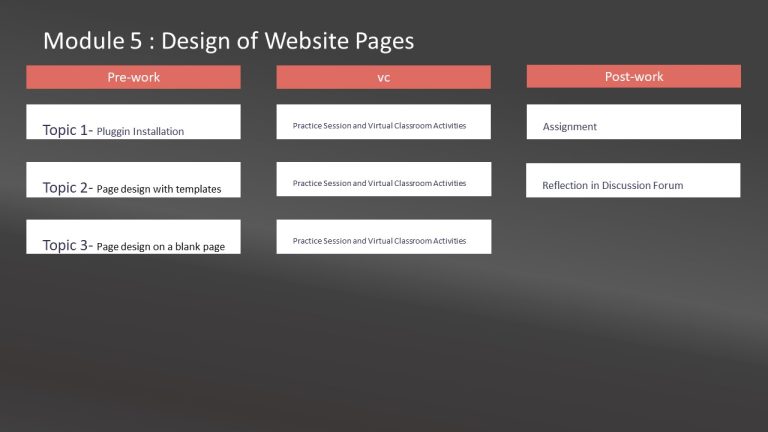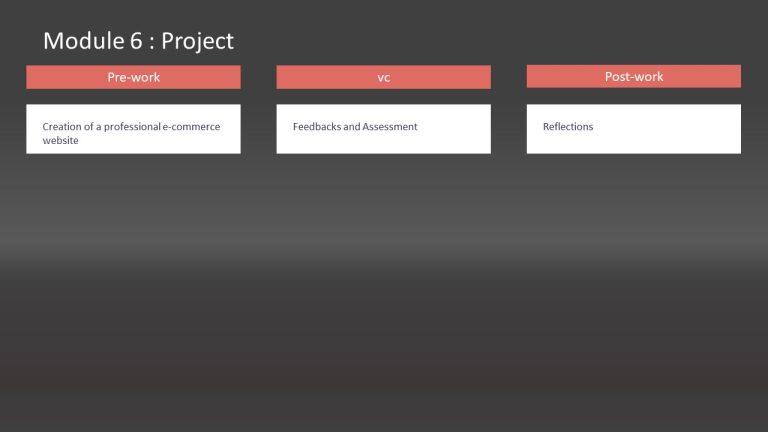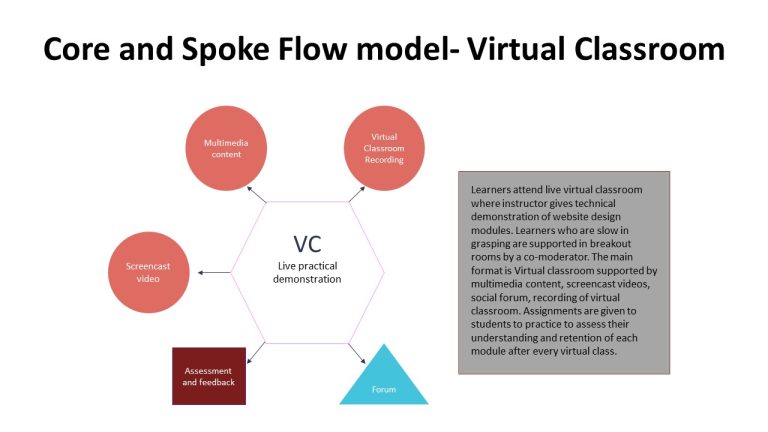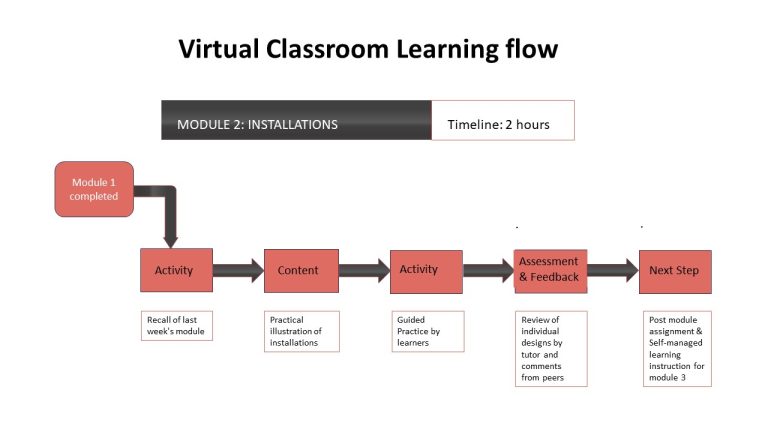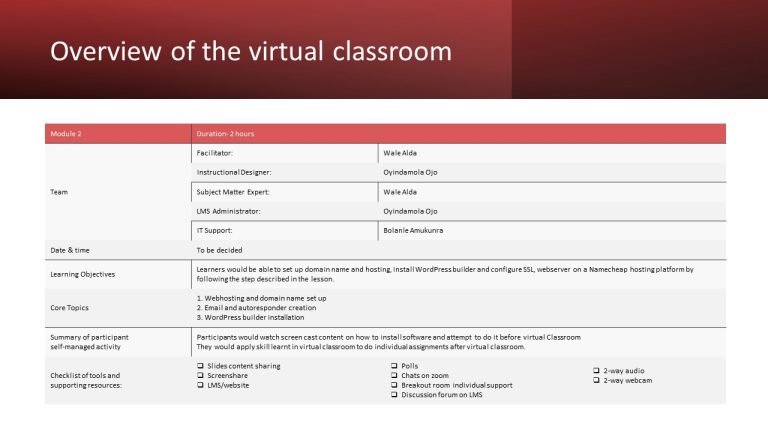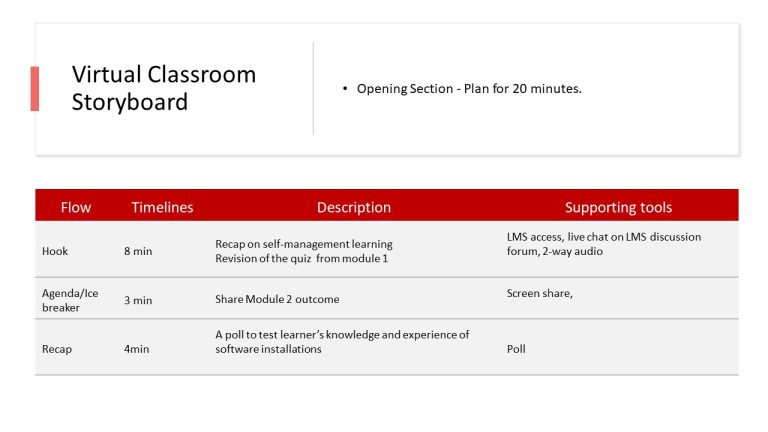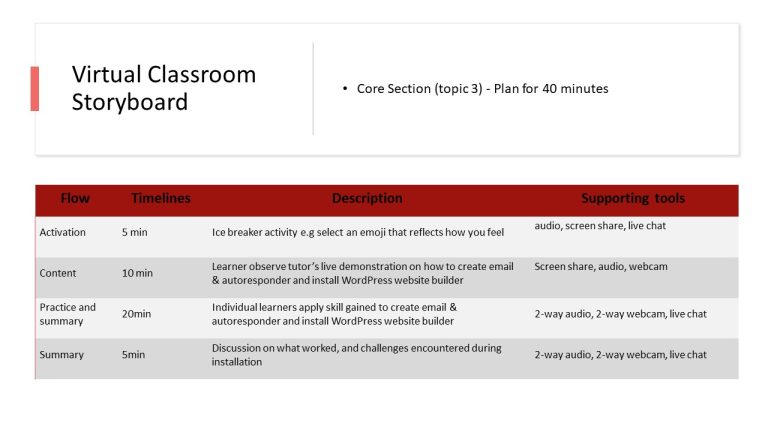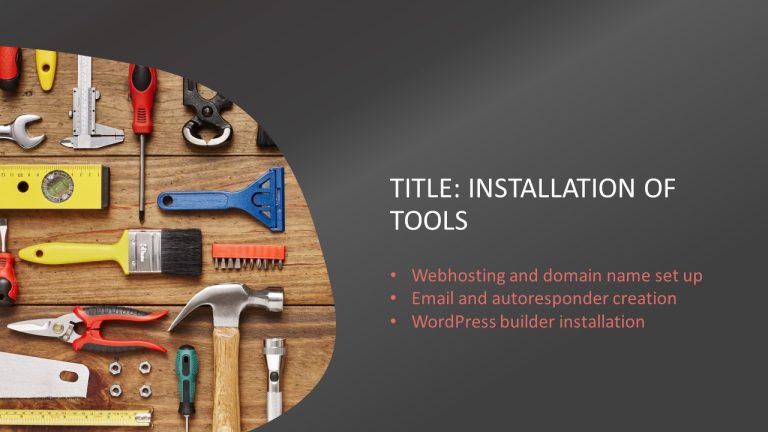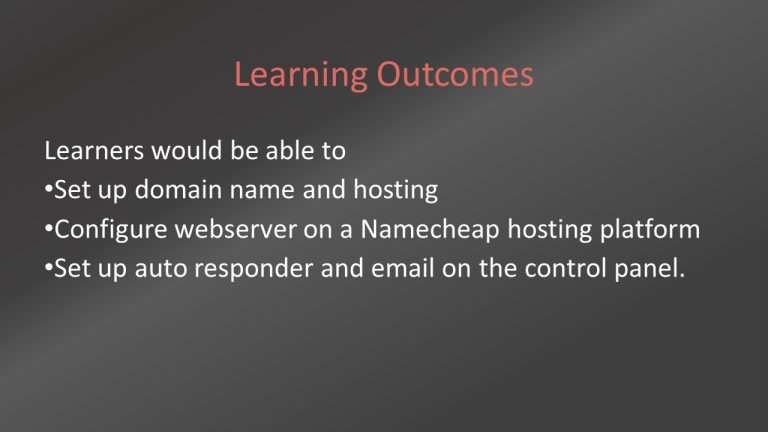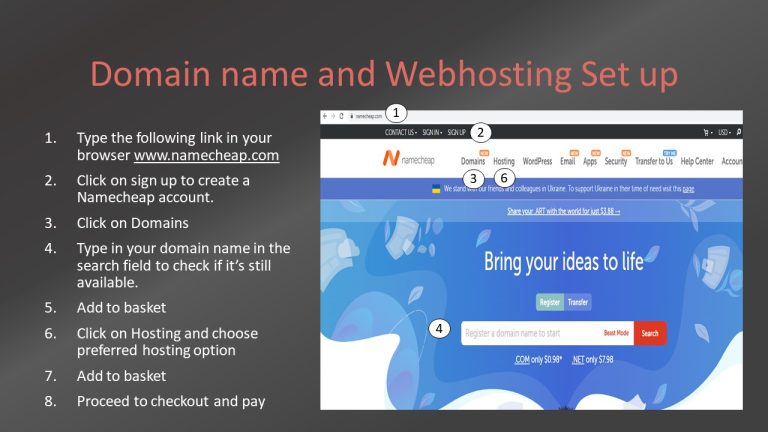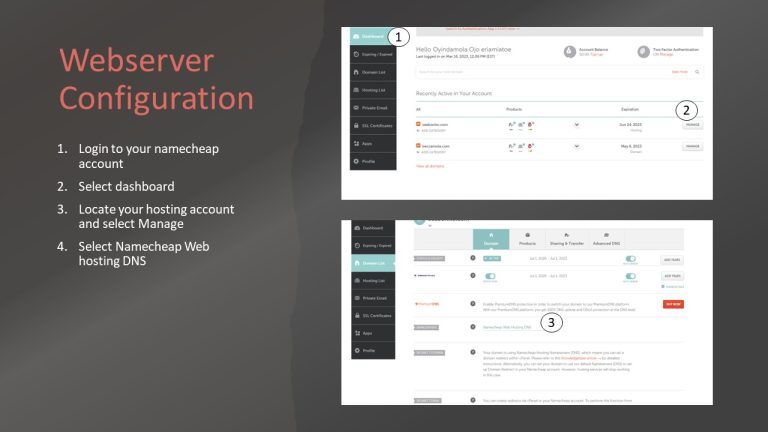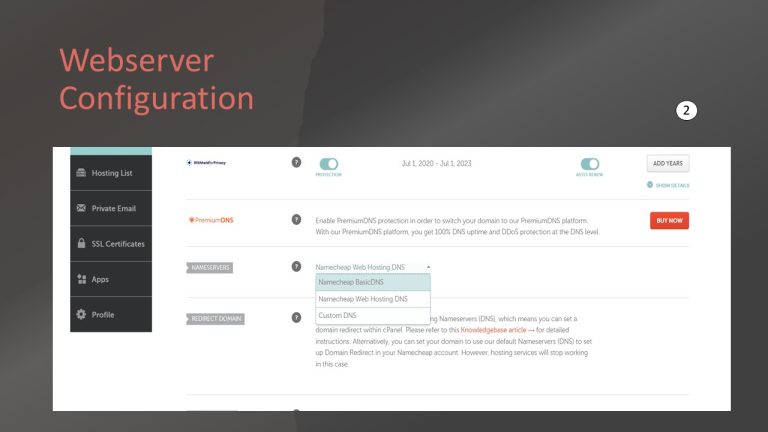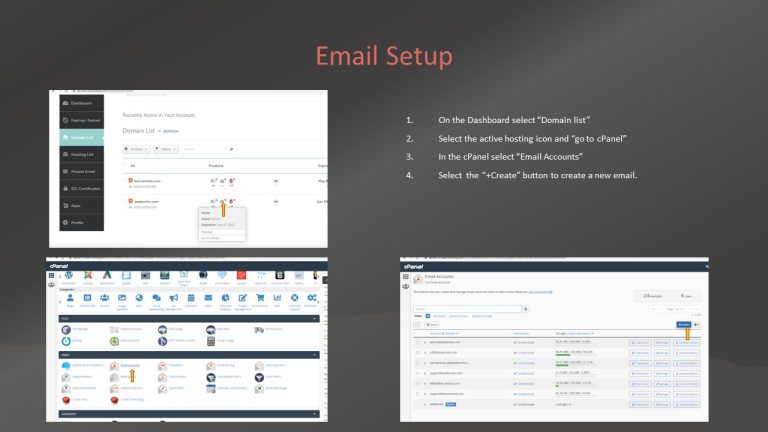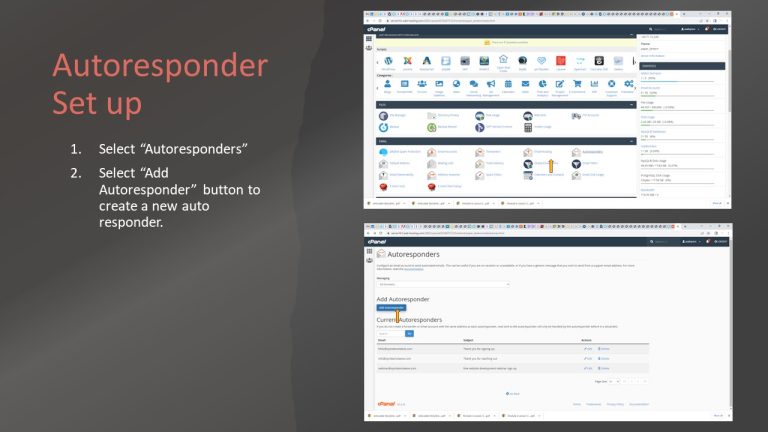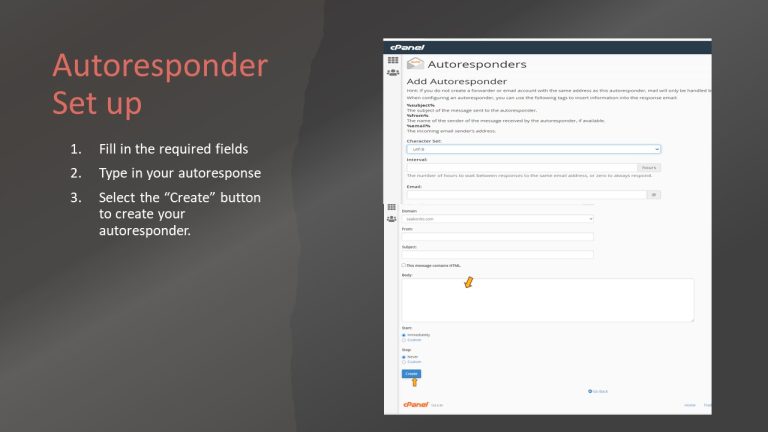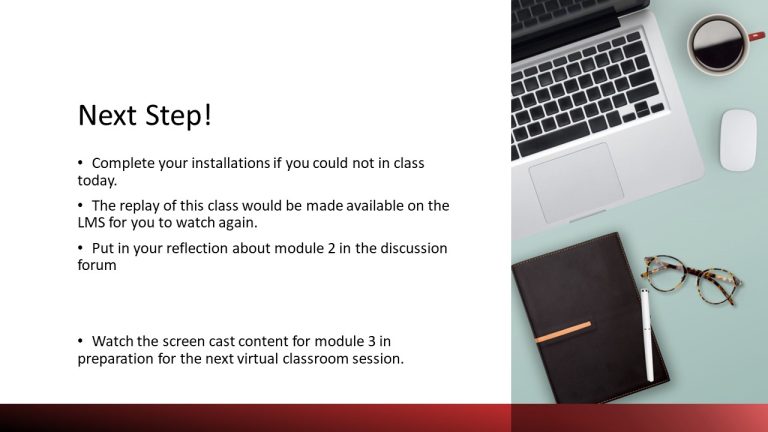Website Design Course
Blended Delivery
.

Website Design: Virtual Workshop Design Process
This is a workshop-based learning experience design involving blended delivery, created to help small business owners to have a credible and reliable online presence.
1. Overview
A digital services company wanted to creat a simple course in website design to be taken by small business owners who were finding it hard to make sales during the Covid pandemic lockdown. Many of the audience being targeted had social media presence but were lacking competitive advantage as they were not considered credible by serious buyers because they did not have websites.
2. Process
I carried out the project by adopting the ADDIE framework and DESIGN THINKING approach which is similar to the agile SAM methodology involving prototyping and iterations.
ANALYSIS: This involved establishing the WHO (audience) and WHY(Learning outcomes in relation to Business goal) of the project with the stakeholders.
DESIGN: Working with the Subject Matter Expert, SME at this stage, we determined the WHAT of the project by creating a content plan based on the learning outcomes. I also established the HOW, that is, an engaging learning experience.
DEVELOPMENT: The development of learning prototype, iterations and final content.
IMPLEMENTATION: Finalizing, publiishing and delivering the learning .
EVALUATION: Assesments, feedbacks, data tracking and reporting.
At the end of the analysis and design stages, the stakeholders are handed the Scoping document which answers the questions, WHO? WHY? WHAT? AND HOW?
ANALYSIS
WHO-Persona Analysis
WHY- Business goal analysis and learning outcomes
THE WHO - PERSONA ANALYSIS
The personas were created from the analysis of the data gathered during the participation of the audience in a free workshop conducted on facebook and survey created using google forms. A group of small business owners was gathered through facebook Ads and whatsApp broadcasts and introduced to the benefits of the course. A large percentage of them showed interest and futher data was sources through answers to questions in the survey.
The survey had questions that helped in understanding their demography, busines needs ,what type of website they were interested in, their technological competencies, lifestyle, prefered learning style, tools they had access to, etc
My personas represent small business owners aged from 35 to 48 years. Kemi has a very busy schedule and wants to reduce workload by digitizing her product. She has had a good eLearning experience in the past. Pamela is a chef who produces special recipes and wants to expand her reach internationally by selling online. She is afraid of the impact of losing her social media account hence her audience. She cannot afford a professional website developer and so wants to start by developing her website by herself. Her previous experience with digital learning left her overwhelmed with knowledge dump and no guidance. Victor owns a cleaning service and lives in the United States which is a 6 hours time zone difference from the instructor and other learners. He is comfortable with digital learning and prefers self-managed learning.
They all have personal computers, are familiar with zoom video conferencing and considerable access to data but no coding skills. Based on the learners’ tight schedules and preferences, I have designed the course to be blended. There would be sufficient support for the learners in a discussion forum as well as in the virtual classroom VC by the trainer and a co-moderator. The virtual classroom would hold on the Zoom video conferencing app as most learners have experience using it.
THE WHY- LEARNING OUTCOME
Meeting with the stakeholders gave insight to the reasons why the learning program was being carried out. Apart from ensuring that the prospective learner gain the digital skill to be able to build and maintain their websites by themselves, another success factor for my client was revenue generation. Hence, It was very important that we ascertained that the targeted business owners knew they needed the course by conducting learner's need analysis during persona analysis. This exercise done with the stakeholders and Subject Matter Expert also revealed the learning gap and training gap of the learners as shown in the image below.
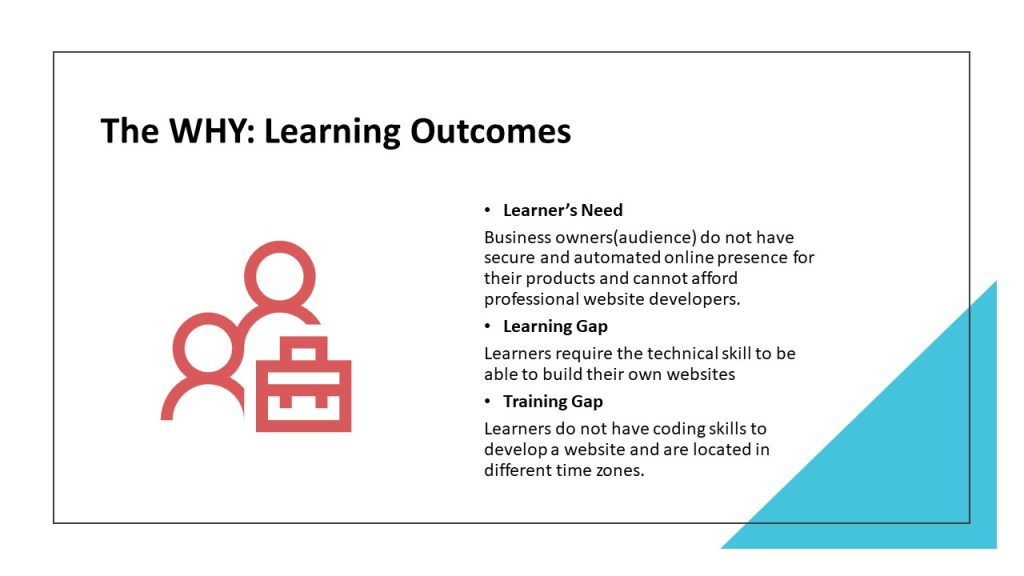
Moreover, the in-depth analysis of the persona and their learning needs helped in curating SMART learning outcomes for the workshop (Figure 5). The ABCD structure for creating learner's outcome (Figure 6) was used in crafting each objective to include the Actor, Behavior (Objective and outcome in form of verbs and goals) and Condition which is the how.
Furthermore, I adopted the bloom’s taxonomy scaffolding model (Figure 7) to link learning gaps to the learning objectives ranging from the Lower Order Thinking's Skills (LOTS) to the Higher Order Thinking Skills (HOTS).
This exercise would help in the design phase to ensure that we map the content starting with the easier activities and progressing to the more challenging ones.
DESIGN
WHAT- Content Mapping(Micro and Macro)
HOW- Learning Experience: The main design principles adopted in the Virtual classroom delivery design are The Blend, Flow model, Ground Rules and Lesson Plan . Based on these principles, I established the follwing:
THE WHAT- CONTENT MAPPING(Micro and Macro)
The Learning objectives created with the Bloom's Taxonomy model as shown the Figure 8 reflect the sequential order of the modular structure I created for the SME to map the contents for the course. The Lower Order Thinking's Skills LOTS was reflected in the first module which involved listing and identifying tools and software for website design while the HOTS was used in the last module where the learners would design the website at the end workshop. This is to avoid demotivating them through exposure to the difficult content at the beginning of the program.
Macro Content Planning- I worked with the Subject Matter Expert to do a high-level mapping of modules(Figure 9) based on the structure I created in figure 8. Breaking down the learning outcomes helped in chunking the modules to prevent knowledge overload for learners. My content creation method was TOP-DOWN approach
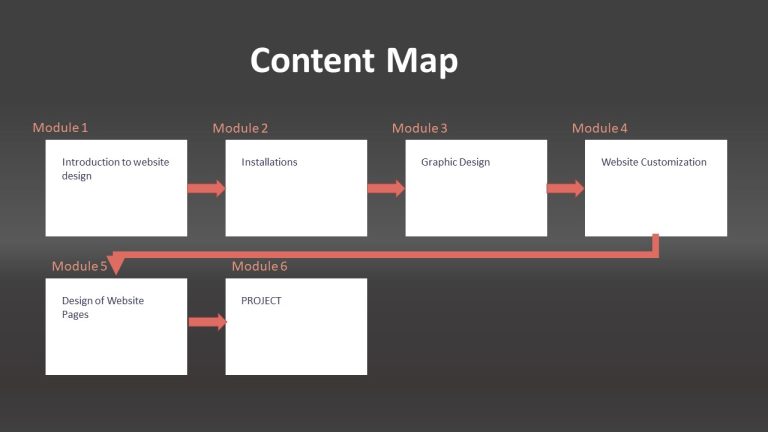
Micro Content Planning- This involved the detailed breakdown of topics. The content consists of instructions and videos for no-code template-based designs because learners have no coding skills. Module 1 was designed to be a self-managed multimedia content using Articulate Rise because it is the introduction to the entire course while modules 2 to 5 were created as screencast videos for virtual classroom delivery.
Figure 10 below shows the breakdown of topics for Module 2 used as a prototype for the virtual classroom VC sessions while figures 11-16 illustrate the learning format for all the modules which includes asynchronous and synchronous formats. The pre-work happens when learners go through the screencast videos for the topics before attend the virtual classroom VC. Post-work occurs after the live-classroom sessions and learners get to do their individual assignments and also engage in social learning in the discussion forum.
I designed the assessments for modules 1-5 to have formative assessments in form of practical assignments while the final project is summative involving the creation of an ecommerce website.
THE HOW- LEARNING EXPERIENCE
Learning experience involves high level and micro scoping plans and learning flow. The delivery mode and format are shown in figure 17 below. I designed the delivery mode as blended such that each module has self-managed content, social learning in discussion forum and VC sessions with the flow model being core and spoke (figure 18) for each module. The core delivery mode is virtual classroom supported by self managed and social learning. This is because most of the modules involve practical exercises with learners requiring guidance as they learn and practice. Hence, the learning flow during each instructor-led session is planned as illustrated in figure 19 to ensure effective learning.
Moreover, most of our learners have tight schedules and are in different time zones hence, schedules and contents are designed to favour different time zones providing the flexibility to engage with all formats when convenient for them. As a result, each module including the project is to be completed in 1 week making the workshop last for 6 weeks.
Assessment strategy and feedback strategy: The assessment is both formative and summative. Modules 1-5 have formative assessments involving feedbacks, practical assignments reflective comments in forum and quizzes to check if the learning outcomes are being achieved as we progress in the workshop. The summative assessment is a project involving the creation of an ecommerce website which requires demonstration of all skills learnt from module 1 to 5 thereby, reinforcing the learning. The VC does not require many activities for engagement and motivations because the workshop already has guided practice sessions. Regardless, I included ice breakers, class exercise, feedback sessions and live chat to motivate learners. One major support feature for learners is the presence of a co-moderator to offer technical support to learners who may have challenges with technology.
Instructional Design Plan:
In this process, I would be including only the VC instructional design plan. While the result of the who, why and what is the same for the VC content and the multimedia content, the how which demonstrates the design and development process is different for both hence I would be showcasing the multimedia content design and development as another project.VC Design plan:
- Wireframing
- Lesson plan (Writing VC text-based storyboard)
VC Wireframing: I designed a one-page visual wireframe showing the flow of the classroom session based on instructional design principles. Building on the virtual classroom learning flow demonstrated in figure 19, I adopted the principle of Gagne’s nine events of instructional design for an engaging action-based eLearning. The classroom activities were seperated into separated into 3 sections, as shown in figure 21, namely Opening, Core and Closing sections serving as a foundation for the development of the storyboard.
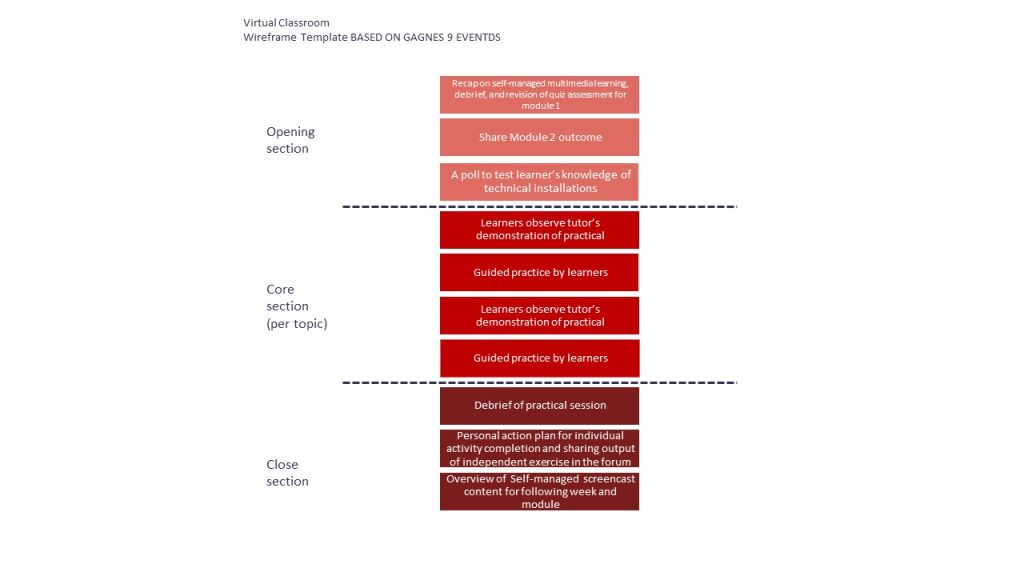
VC Storyboarding: A storyboard in Virtual classroom delivery is also know as a Lesson Plan . Narrowing down to module 2, my design featured the following activities adhering to Gagne’s nine events design principle
-
Gaining attention- Recap on self managed multimedia learning and revision of quiz from module 1
Stating Objectives- Sharing of module 2 Objectives
Recalling prior learning- A poll to test learner’s knowledge of technical installations
Presenting Stimuli- learners observe learners observe tutor demonstrating technical installation
Providing learning guidance-Learners observe tutor’s demonstration of practical
Eliciting performance- Learners engage in guided practice of content demonstrated by tutor
Providing Feedback- feedback to learners
Assessing performance- Debrief of practical session
Enhancing Retention- Learners go home with assignments to practice further.
Ground Rules: While developing the Lesson plan, ground rules were set on how and when to use the various tools made availabe for the live sessions. These tools are listed in the overview of the virtual classroom.
eLEARNING DEVELOPMENT
This involves screencast videos created on Screencast-O-matics, slide decks for the VC sessions and a multimedia content for module 1 "introduction to website design". Below are the softwares used in developing the contents for the virtual classroom sessions
POWERPOINT SLIDE DECKS
I applied visual design theory like CRAP, allignment , contrast and repitition to make slide designs accesible.
IMPLEMENTATION
The delivery of the workshop is designed to be implemented using the following means:
-
Video Conferencing on zoom
Self-paced content on Learning management System LMS
Social learning on LMS
VIRTUAL CLASSROOMS SESSIONS: My delivery plan for the VC sessions is based on the 5 steps including:
- Planning>Preparation>Opening>Core>Close
Preparation: We would log in early into the virtual class early to do technical checks. Audio check and ensure camera on to track engagement, foster connection and facilitate communication.. Also screen share would be tested to ensure slide deck is well displayed. A welcome message would be written in the live chat before participants arrive.
Open, Core and Closing stages: These involve activities set up in the design phase using Gagne’s nine events of instruction as shown in the wireframe and lesson plan. I created the slide deck using Microsoft PowerPoint for the display of the module instructions during the live sessions. Screen-to-matics software was used to record screencasts of technical instructions and uploaded on LMS for self-managed learning. Zoom recordings were also activated and replays links made available on the LMS for learners to watch again if required.
I designed the Core Stage by utilizing four steps namely
- Activation- Ice breaker activity
Content- Tutor demonstrate the application of technical content
Practice- Learners repeat the demonstrated application as guided practice
Summary- Discussion on what worked, and challenges encountered.
LEARNING MANAGEMENT SYSTEM:
Course Configuration
Uploaded on the LMS are the self-paced content. The screencast videos below show how I managed the LearnDash LMS. I configured courses creating learning paths and assessments such that learners had to complete certain lessons, assignments and quizzes before progressing to the next lesson. I created notification messages for communication and also managed the forum and sorted technical issues encountered by learners.
Learning Analytics: Tracking and Reporting The figures below show CSV data generated from the learning management system revealing the activities of learners in relation to their course content and assessment for example course progress and completion by learners, time spent in completing quizzez, how many attempts were made and result of the assessments.

EVALUATION
The evaluation Strategy I designed for this workshop is based on 5 stages of Addie and Kirk Patrick's model of evaluation.
Evaluation is done during the analysis stage with the use google forms to get feedback from learners to understand their needs, learner's gap and technology and learning preferences. Understanding the business goals from stakeholders also helped in merging learning outcomes with content from SME and learner's preferences and challenges.
In the Design and Development stages, feedback received from the SME and stakeholders concerning storyboard and slides prototypes guided in redesigning the lesson plan and slides.
Evaluation in the Implementation stage was planned to determine learner's experience and understanding of content. There level of motivation would be determined through observation of their engagement with activities in class while there understanding and retention would be checked through the result of the quizzez and assignments given to them.
Moreover, their ability to successfully build their own business websites in the project assigned to them in the fginal module would demostrate the acquistion of the skill being passed to them.
Finally, the evaluation of this success of the worshop and impact on business goals in the long term would be determined by how many more business owners would subscribe to the course based on the review from the first cohort.

3. Results and Takeaways
Data from the survey helped us in determining the proposed learning experience as seen in the storyboard slides in subsequent lessons. Iterations were done as learners engaged with the learning materials because we kept getting feedbacks by observing their perfomances and also by asking them how we could improve on their learning experience. This resulted in us changing the teaching style we started with, which was self-paced elearning, to blended learning which included instructor-led sessions on zoom combined with video courses, quizez and practical graded project.
I used to adopt the BOTTOM-UP approach of content creation by creating learning outcomes from content already created. However, creating my persona and learning experience based on learner's need and business goals gave more insight to the kind of content, tools to consider in creating engaging learning content and experience for my audience.
The first screencast videos recorded were done without first writing scripts. These resulted in a lot of time wasted in recreating and editing videos. This experience made me realise that scripts are vital in screencast video recording to reduce the length of video and avoid sounding unprofessional.
Finally, I learnt about the application of AI to instructional design after the completion of this project and found out that it would have been helpful in generating fun activities for gamification and in designing the wireframe.
MULTIMEDIA INTERACTIVE COURSE
This is the interactive course content for the self-paced learning that learners are expected to do before the virtual classroom session in module 1. The design, development and implementation of a multimedia course involves a different process from that of a virtual class room and hence was done as a different project.






